In cellular networks, the rapid growth of mobile devices and traffic load drives the exploration of wireless communication solutions with better energy efficiency and spectral efficiency. Device-to-Device (D2D) communication is a transmission scheme that allows wireless devices to communicate directly without forwarding through the infrastructure (eg, base station) and improve the performance of the cellular network [1]. Because of the proximity of communications, D2D communications have the advantages of low latency and low energy consumption. However, as a large number of wireless devices constantly try to access the network, the D2D-supported wireless communication device may be a low-power device (for example, a machine type device [2-3]). This equipment is mainly supported by fixed energy sources, such as batteries. As a result, these low power devices supported by D2D communication have a limited life cycle [3]. Replacing batteries for such wireless devices or charging them through the power grid is an unrealistic or costly task.
Therefore, to extend the life cycle of such low-power devices, Energy Harvesting (EH) technology has been proposed to provide electricity support for such devices [4]. Energy harvesting technology is a green energy technology that converts environmental energy (such as solar energy, wind energy, etc.) into electricity. However, due to the volatility of the environment and the immaturity of energy conversion technology, this emerging energy support technology is highly random. Therefore, in the D2D communication for energy collection and charging, how to effectively manage the collected energy to meet the network transmission requirements is a practical issue.
Recently, D2D communication research on energy harvesting and charging has focused mainly on designing effective transmission and resource allocation mechanisms. In terms of access control, the literature [5] proposes a statistical online learning and mode selection scheme for sub-bands to reduce the switching overhead and computational complexity of sub-bands. In EH Charging Cognitive D2D Communication, [6] proposed two different spectrum access strategies: random access and priority access, and analyzed their performance in terms of transmission probability and SINR interruption probability.
In addition, how to effectively allocate resources (power and spectrum) is also a hot topic of existing research work. Literature [7] proposes a power allocation mechanism for maximizing the total rate of energy collection at the transmission end in a Gaussian interference channel. Considering the situation with the greatest energy efficiency, literature [8] studied the effect of different practical constraints (such as energy constraints and battery capacity constraints) on the network. For effective spectrum allocation, literature [9] and [10] investigate the issue of maximizing total rates and minimizing energy consumption.
The above research work considers one-to-one channel multiplexing scenarios for cellular users and D2D users. In this multiplexing mode, the channel resources of the cellular user will be idle when the D2D user's energy for this energy gathering charge is lost. In order to better meet the current design requirements for spectral efficiency, multiple energy harvested D2D communications are allowed to multiplex the same cellular user's channel resources for transmission. In this case, spectral efficiency can be improved by covering channel gaps due to energy loss between users. Based on the above analysis, this paper mainly focuses on the problem of power allocation under the scenario where multiple energy-gathering and charging D2D users multiplex a channel resource of a cellular user.
System Models and Mathematical Modeling
1
This article considers the single-cell scenario shown in Figure 1. N pairs of EH-based D2D pairs (EH-DP) that have an energy collection function can reuse the uplink spectrum resource transmission data of the cellular user.

This paper does not consider the spectrum allocation problem, only planning the matching power distribution problem. Cellular users are powered by traditional batteries. Each EH-DP has a sender and a receiver. Assume that the EH-DP's sending node has an energy collection function and is equipped with a wireless capacity battery to store power. Since the signal decoding process at the receiving end is very low power consumption, this paper does not consider the power allocation of the EH-DP receiver. At the same time, the transmission process of the entire system considers the transmission of time slots.
As shown in Figure 1, any EH-DP communication link will interfere with cellular users and other ED-DPs. Similarly, cellular users will also interfere with all EH-DPs. Assume that the cellular user is denoted by symbol c, EH-DP is denoted by d, and the base station is denoted by B. In the time slot t, the channel capacity (Shannon capacity) of the cellular link and the EH-DP link can be expressed as follows:
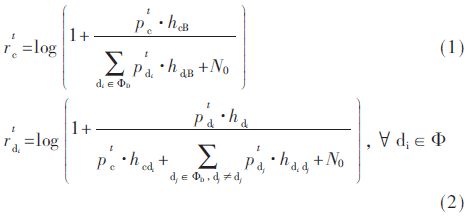

1.1 Energy Harvesting Model
This scheme assumes that the energy harvesting model of EH-DPs obeys the independent compound Poisson distribution as shown in formula (5) in [11]. That is, each time slot, there are K energy packets arriving at the EH-DP user. The size of each energy packet is fixed at eu. Where K is the Poisson distribution with an average of λ. Therefore, the energy model of the EH-DP user di is shown in Figure 2.
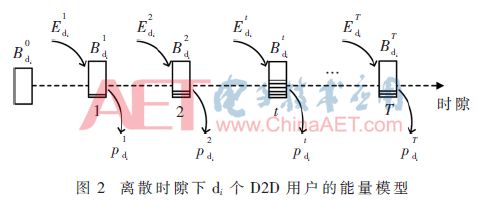
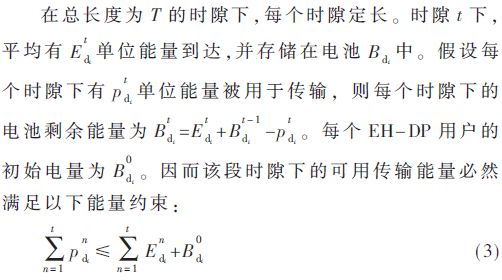
In this scenario, the storage and consumption of energy is only used for communication, and the battery has no power loss. At the same time, the base station knows the energy state information and channel state information of all the nodes, and the base station can use this information to perform power control on the user.
1.2 Mathematical model
This article considers optimizing the total transmission rate of all EH-DP communication links in a network during a certain time interval t under the premise of guaranteeing the transmission rate requirement of cellular users:
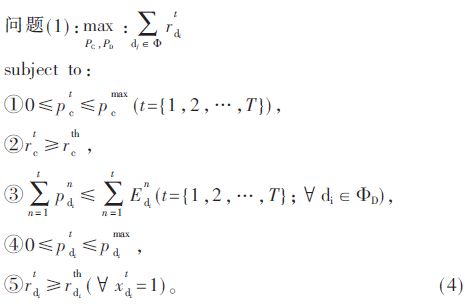
Among them, PC, PD represent the set of decision variables that represent the power decisions of the cellular user and the power of the EH-DPs. The transmission rates of cellular users and EH-DPs are shown in equations (1) and (2), respectively. Constraint 1 and Constraint 4 represent the maximum transmit power constraints for cellular users and EH-DPs users, respectively; Constraint 2 is the minimum transmission service quality constraint for cellular users; at the same time, if EH-DP is selected for transmission, the corresponding transmission rate should also be obtained. Represented by constraint 5; 3 is the energy constraint of EH-DPs during transmission.
solution
2
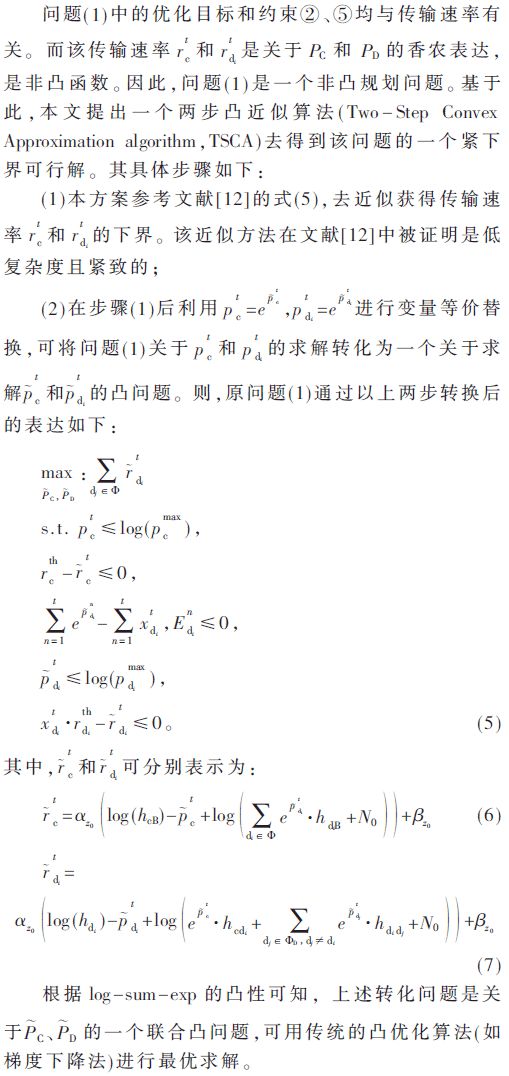
Theorem 1 According to the analysis, according to the transmission rate requirement constraints 2 and 5 of the CU and D2D in the problem (1), it can be seen that a D2D user pair capable of transmitting data in a certain time slot must satisfy a basic energy requirement:

Simulation analysis
3
In a cellular scenario with a radius of 800 m as shown in Fig. 1, the base station is located in the center of the area. Cellular users and D2D users are randomly distributed and obey the following rules: Since spectrum matching has been completed, the spacing between cellular users and EH-DP users in the simulation must not be less than 200 m to avoid serious mutual interference; similarly, EH-DP The spacing between them must not be less than 80 m; however, the distance between the sender and receiver in EH-DP is randomly distributed between 20 and 50 m. Other parameters used in the simulation are shown in Table 1.
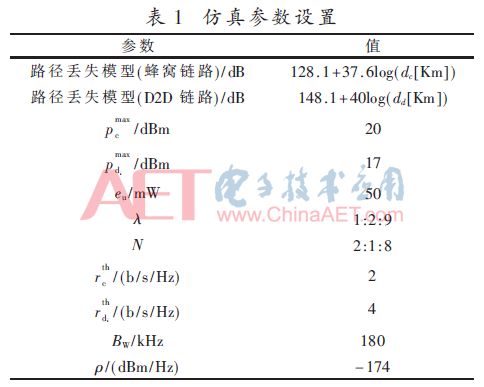
First, in order to verify the effectiveness of the scheme, the algorithm of this paper is compared with the violence search scheme to verify the effectiveness of the proposed approximate scheme (TSCA). The scheme of brute force search can get the optimal power allocation strategy, but its search complexity is too large to be suitable for applications where the delay of this decision is in the millisecond level of wireless applications. Without loss of generality, this paper only verifies the scenario when the number of EH-DPs nodes N in the network is 3 and 5, and analyzes the average available transmission rate of EH-DPs when the average collected energy packet λ is 1-9.
As shown in Fig. 3, in the scenario where N is 3 or 5, the TSCA algorithm can approximate the optimal solution approximately at the average attainable transmission rate performance when any energy packet reaches the size. That is, the algorithm proposed in this paper is suitable for the power allocation problem of multi-EH-DPs users and cellular users sharing the channel scenario, and has a lower algorithm complexity.

Secondly, the performance of D2D communication for energy harvesting and charging is shown in Figure 4 for different numbers of EH-DP users and different energy arrival scenarios.
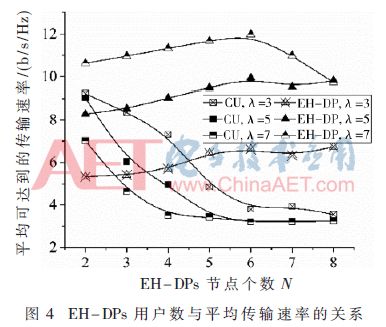
In Figure 4, the average transmission rate of cellular users decreases with the number of nodes (or as the arrival of energy packets increases). In addition, the average transmission rate of EH-DP users grows with the increase of energy packets. This is because as the number of users or energy packets increases, the probability that an EH-DP user requests an access channel for transmission will continue to increase. This leads to an increase in the transmission rate of EH-DP users. At the same time, cellular users will suffer more interference from EH-DP users, which will reduce the cellular user's transmission rate. However, due to the constraints of cellular user transmission requirements, the minimum transmission rate of cellular users will be guaranteed, such as when the number of EH-DP users is greater than or equal to 5, and the energy packet is greater than or equal to 5. On the contrary, if the energy packet reaches a certain level, the EH-DP user's request is saturated, and the mutual interference between the EH-DP users also increases. This also results in that the average transmission rate that the EH-DP user can obtain will decrease when λ is greater than or equal to 7 and the number of EH-DP users is greater than or equal to 6.
in conclusion
4
In this scenario where multiple D2D users with energy collection and one cellular user multiplex uplink spectrum resources, under the premise of energy constraints and meeting the transmission requirements of cellular users, the goal is to maximize the transmission rate of D2D communication links. Optimal power allocation issues for cellular users and D2D users. Since this problem is a non-convex programming problem, it is difficult to find the optimal solution in polynomial time, especially when the network size is large. Therefore, this scheme proposes a two-step convex approximation algorithm. Through theoretical and simulation analysis, we can see that the algorithm proposed in this paper can get the approximate optimal feasible solution of the problem with lower complexity.
The Privacy Screen Protector can display a black screen directly in front of the screen at an angle greater than 30° to effectively block the sight of people next to it, while achieving a perfect balance between black screen privacy and daytime clarity.
The Screen Protector can protect the edges and gaps of the display so that it can extend to the entire screen surface, thereby achieving maximum coverage without any exposed space.
The Self-Healing Screen Protector can provide the best protection for your phone from drops, bumps, scratches and normal wear and tear. Using an oleophobic waterproof coating can prevent sweat and grease from remaining on your fingerprints, keeping you simple all day long.
The 0.14mm thick Ultra-Thin Protective Film has a "real touch" feel and ensures fast response performance.
If you want to know more about Privacy Screen Protector products, please click the product details to view the parameters, models, pictures, prices and other information about Privacy Screen Protector.
Whether you are a group or an individual, we will try our best to provide you with accurate and comprehensive information about the Privacy Screen Protector!
Anti-peep Screen Protector, Privacy Screen Protector, Anti-spy Screen Protector, Privacy Protective Film, Privacy Hydrogel Film,Anti-peeping Screen Protector
Shenzhen Jianjiantong Technology Co., Ltd. , https://www.tpuscreenprotector.com